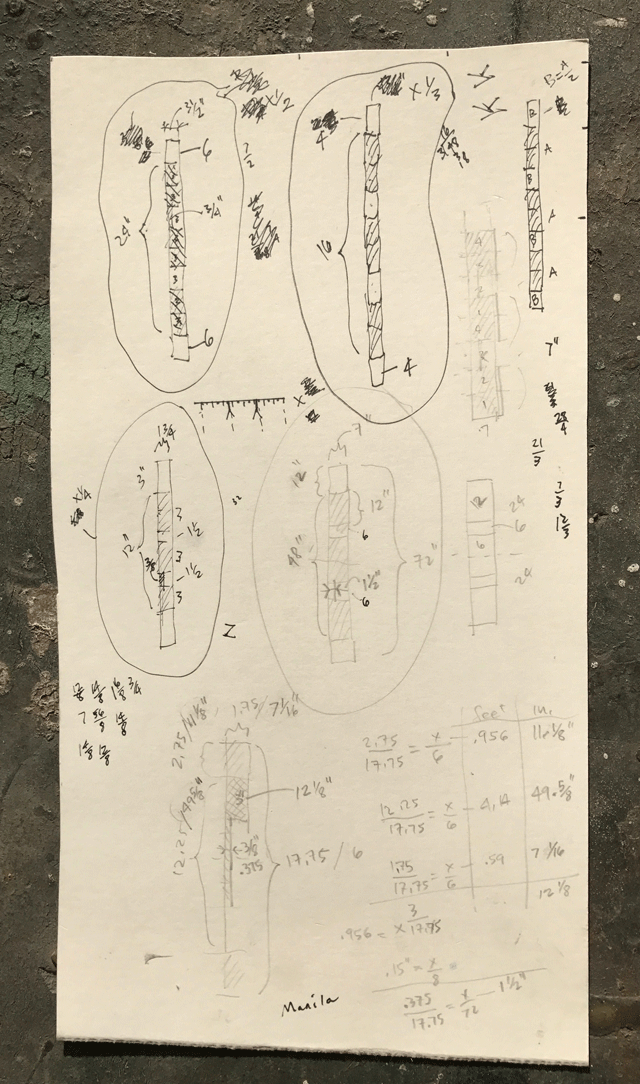December 29, 2016
December 27, 2016
Who are we?



The places in which I have lived, my racial and cultural heritage, my occupations.
Artists today are encouraged to express their identity. Who am I, then? Who are we? Isn't identity a complex for all of us?
"Tell me, Muse, of the man of many ways,
who was driven far journeys"
― Homer, The Odyssey
December 21, 2016
GS DH RV: 01/12/17
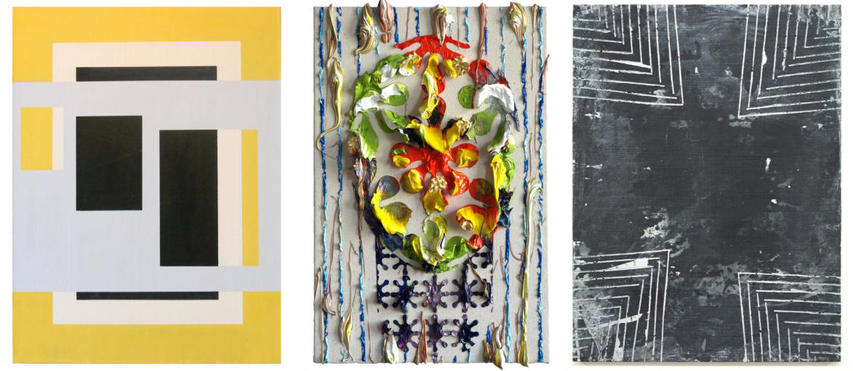
Left to right: Gary Stephan, Dennis Hollingsworth, Rafael Vega
This coming January 12th, 2017, I will be grouped in a show at Hionas Gallery in NYC's Lower East Side with Gary Stephan and Rafael Vega. Naturally, I'm delighted.
Gary is a legend in abstract painting. A graduate of the San Fransisco Art Institute, studying under Diebenkorn, he arrived in the Big Apple in 1968, was a studio assistant to Jasper Johns, sold out his first solo show to Philip Johnson, was included in the Whitney Biennial in 1972. And this is only the story of the beginning of his career. He's seen it all and steered by his own light while the tides of art world fashion swirled around him incessantly.
Rafael's first degree was in chemistry before he switched to art in his home island of Puerto Rico. He went to grad school in the School of the Art Institute in Chicago, graduating in 2012. He was included in the esteemed Phaidon survey book Vitamin P3 and he has been recently acclaimed by trusted art critics such as Barry Schwabsky.
I was able to visit both of their studios last week and with each I was immersed in conversations that were far too short even though they had lasted for hours. Rafael's place is in the badlands of Bushwick. His studio packed with paintings in progress, one room hung with experiments in large scale and another room hung with smaller finished paintings. His walls were his notepad and scratchpad, a rebel aesthetic that is also mirrored in his finished paintings. Gary has lived and worked in the same location at the extreme West end of Canal Street overlooking the Hudson River for 40 years, a plum studio that was surely the badlands of Manhattan in the 70's.
I'm happy to be bracketed by the alpha and omega of these two artists, generations apart. We are all painters of abstraction, and more. We are a specific species of painter that appreciates the continuity between abstraction and its' other, representation. One of us, apparently "pure" and one of us apparently "dirty", I think we all understand and relish the currents between perception, apperception and aporia.
There are two other articles that I had encountered online a few days after the studio visits that for me shown a light on both of these artists. The excerpts that I will feature below will require some introduction.
During my studio visit with Gary, he talked about how he subtly runs visual systems against each other. Pointing to a recent painting where he exploited a suggested foreground and background in a way that would cause -yet frustrate- a viewer to trace a visual cause and effect, I suggested that he was collaging chapter 3 with chapter 5 from Rudolf Arnheim's Art and Visual Perception. I was grateful that Gary laughed in agreement. Below this post, you will find links that might illustrate what I mean by these distinctions and their internal contradictions. One one of the links, an interview with Chicago's infamous Bad at Sports, Stephan described how his painting is inspired by Manet's Luncheon on the Grass. The disjunctive visual fields that had upset so many people a century ago required the viewer to make connections for themselves and not rely on an external authority to instruct meaning for them. This lesson is evergreen. There are yet too many scripts and external authorities in art nowadays.
I think this excerpt from This is your brain on art: a neuroscientists lessons on why abstract art makes our brains hurt so good tells the story quite well:
In abstract painting, elements are included not as visual reproductions of objects, but as references or clues to how we conceptualize objects. In describing the world they see, abstract artists not only dismantle many of the building blocks of bottom-up visual processing by eliminating perspective and holistic depiction, they also nullify some of the premises on which bottom-up processing is based. We scan an abstract painting for links between line segments, for recognizable contours and objects, but in the most fragmented works, such as those by Rothko, our efforts are thwarted.(Emphasis, mine.)Thus the reason abstract art poses such an enormous challenge to the beholder is that it teaches us to look at art -- and, in a sense, at the world -- in a new way. Abstract art dares our visual system to interpret an image that is fundamentally different from the kind of images our brain has evolved to reconstruct.
Kandel describes the difference between "bottom up" and "top down" thinking. This is basic stuff for neuroscience students, but brand new for art historians. Bottom up thinking includes mental processes that are ingrained over centuries: unconsciously making sense of phenomena, like guessing that a light source coming from above us is the sun (since for thousands of years that was the primary light source, and this information is programmed into our very being) or that someone larger must be standing closer to us than someone much smaller, who is therefore in the distance.
Top down thinking, on the other hand, is based on our personal experience and knowledge (not ingrained in us as humans with millennia of experiences that have programmed us). Top down thinking is needed to interpret formal, symbol or story-rich art. Abstraction taps bottom-up thinking, requiring little to no a priori knowledge.
[...]
But the mind-bending point that Kandel makes is that abstract art, which strips away the narrative, the real-life, expected visuals, requires active problem-solving. We instinctively search for patterns, recognizable shapes, formal figures within the abstraction. We want to impose a rational explanation onto the work, and abstract and minimalist art resists this. It makes our brains work in a different, harder, way at a subconscious level. Though we don't articulate it as such, perhaps that is why people find abstract art more intimidating, and are hastier to dismiss it. It requires their brains to function in a different, less comfortable, more puzzled way.
Regarding Rafael's omega to Gary's alpha, noise is a legitimate part of his visual system. He eases but not erases the boundary between life and art. For example, the pentimenti encountered in his paintings is not earlier strata of aborted painting but instead it is usually the casual wiping of his brush and scraping of excess paint as he sweeps around his usually horizontal working surface. The legacy of Ryman and Fontana loom large in his painting as the various components of support step up to the agency of paint itself. The plasticity of such an expanded field within painting is elicited with blades --serrated and otherwise-- against the resistance of wood and canvas. Layers migrate and trade places front to back and back to front. In a manner that echoes Gary's project, motifs run interference with one another, destabilizing facile coherence.
The second article is from the New York Review of Books, The Brutal Dreams That Came True by Martin Filler, who surveyed a whole bookshelf of information on Brutalism. Let's let Wikipedia make the introduction to this manifestation of twentieth century post war architecture:Brutalist architecture is a movement in architecture that flourished from the 1950s to the mid-1970s, descending from the modernist architectural movement of the early 20th century. The term originates from the French word for "raw" in the term used by Le Corbusier to describe his choice of material béton brut (raw concrete). British architectural critic Reyner Banham adapted the term into "brutalism" (originally "New Brutalism") to identify the emerging style.
I've noticed recently the renewed interest in Brutalism among contemporary architects such as the Berlin based Arno Brandlhuber (images here). Martin Filler does a great job giving a brisk historical overview of the wellsprings of this kind of aesthetic:
However, not every big, tough-looking building, even if made of concrete, is necessarily Brutalist. The new popularity of the subject has prompted another English enthusiast, the graphic designer Peter Chadwick, to assemble an album of images, This Brutal World, which takes the broadest conceivable definition of the style. The author dutifully quotes Banham's dictum that "in order to be Brutalist, a building has to meet three criteria, namely the clear exhibition of structure, the valuation of materials 'as found' and memorability as image."(Emphasis, mine. Again.)[...]
In the introduction to his paean Raw Concrete: The Beauty of Brutalism, the University of Liverpool architectural historian Barnabas Calder declares his infatuation:
I am a lover of concrete. The great outburst of large concrete buildings in the 1960s and '70s, the style known as Brutalism, thrills me. I love the unapologetic strength of these buildings, and the dazzling confidence of their designers in making their substantial mark. I love the optimism they seem to embody, their architecture promising bullishly that new technologies can improve almost every corner of human life. Most of all, I love the way the buildings look: rough, raw concrete, streaked by rain and dirt, forming punchy, abstract shapes; soaring cliffs of tower block or entire cities within cities.
When I see Rafael's painting, I think of the sentences in bold above.
Finally, a word about the ghost of Kasimir Malevich floating in the trio of images that bracket this post. Ages abound between our time and the hundred years ago when Suprematism was first conceived. Ages abound between the three of us in the Hionas show: Gary at 74 years old, myself at 60 (the number still amazes me!), and Rafael at 38. Kasimir's image abounds too: the Black Square, Malevich's later return to his folk inspired roots (representational and stained with the aura of suprematism) and finally his Black Cross.
The thing is, Malevich had this strange habit of scrambling the dates of his paintings. Art historians tend to overlook this... bizarre, I know. When they don't ignore it, they mumble something about Stalin. But if the gulag loomed, wouldn't Kasimir paint in the socialist realist style that would spare him the Siberian adventure? Malevich's late paintings of peasant figures were relentlessly colored and inflected with abstraction. His famous and apparently sober self portrait, colored in absolute terms, was signed with a miniature Black Square. This is not the act of an artist in hiding. Regarding his legend, I think that there is a kind of hagiography of abstract legend to protect, the linear story (Mondrian's Tree) that starts with representation and ends with "pure" abstraction. The scholarship is spotty on Malevich in general, and I doubt that we will ever know the real truth of him. I nurse the idea that the great Russian recognized the continuity between the alpha and omega of representation and abstraction, that one implies the other.
Life is that which is strung between, isn't it?
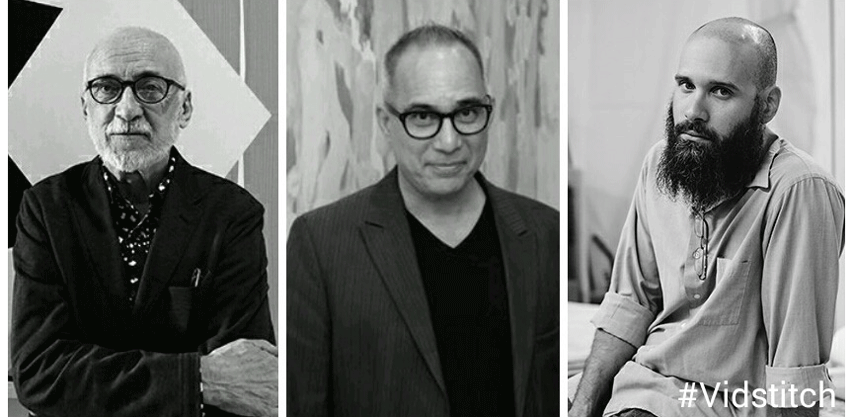
Left to right: Gary Stephan, Dennis Hollingsworth, Rafael Vega
Gary Stephan Interview with Gorky's Granddaughter
Gary Stephan Interview with Bad at Sports
Barry Schwabsky on Rafael Vega
Phaidon (Vitamin P3) featuring Rafael Vega
December 9, 2016
Knowing my strength

Knowing my strength
2016
#535
72"x72"
Oil on canvas
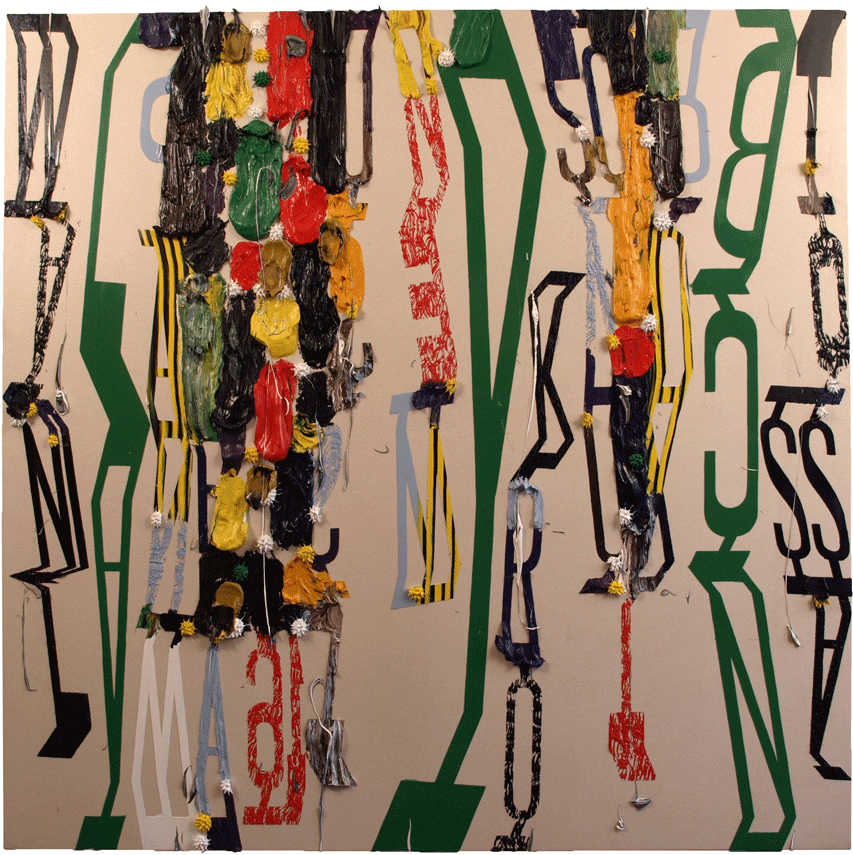
December 5, 2016
What's the most you've ever lost in a coin toss?
Just don't put it in your pocket:
Anton Chigurh: You need to call it. I can't call it for you. It wouldn't be fair.(Year count change, mine.)
Gas Station Proprietor: I didn't put nothin' up.
Anton Chigurh: Yes, you did. You've been putting it up your whole life you just didn't know it. You know what date is on this coin?
Gas Station Proprietor: No.
Anton Chigurh: 1958. It's been traveling [fifty eight] years to get here. And now it's here. And it's either heads or tails. And you have to say. Call it.
Gas Station Proprietor: Look, I need to know what I stand to win.
Anton Chigurh: Everything.
December 1, 2016
The Coin
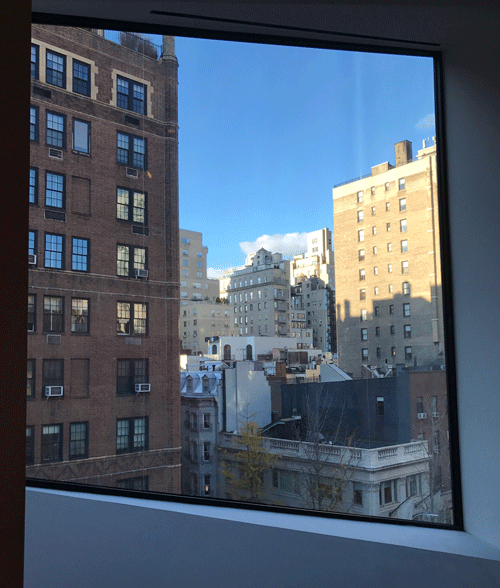
Last weekend, I first went to MoMA and saw the Picabia show, Francis Picabia: Our Heads Are Round so Our Thoughts Can Change Direction
Through March 19, 2017, then I visited MetBreuer and saw the Kerry James Marshall retrospective, MASTRY. I felt fortunate to have seen them in sequence, each informed the other. The major critics in NYC are lauding both and justly so. Both artists have created bodies of work that are magisterial. But I have come away from seeing these shows with minuscule curlicues of critical praise and doubt that I have not read or heard elsewhere.
It's time to air them out.
Much has been made of the mercurial nature of Picabia's oeuvre. Moving in the historicizing sequence gallery to gallery at MoMA is one miraculous gestalt after another. Or seemingly so. It is either a fortune or misfortune to have seen the Duchamp, Man Ray, Picabia exhibition in 2008 at the Museu Nacional d'Art de Catalunya, Barcelona, the subject of a previous blog post. A misfortune, since I could not be as astonished as others seem to be at Picabia, the changeling. A fortune, since I could appreciate the threads that wound Picabia's body of work. From Jennifer Mundy's catalog introduction (page 11):[...] at various points in their careers, the three artists responded to one another's ideas and innovations with works that echoed the interests of the other and in ways which were likely to to have been understood only by the other. That they were able to do this suggests that through discussions and close friendship they had mapped out a common intellectual territory and shared approaches to the formal and ontological questions about the nature of art that, at root, fueled their work. Would Picabia have developed a sexualized vocabulary of machine forms if it had not been for conversations with Duchamp about the meaning of the latter's Bride and 'chocolate grinder' in the Large Glass? Would he have toyed with optical themes without the example of his friend? And was his rebellious stance critical in Duchamp's decision to withdraw from the art world? Did both Duchamp and Picabia pay more attention to photography and cinema than they might otherwise have done because of their friendship with Man Ray? Would Picabia have produced his painting of a hanged glass window, or Man Ray his glass work Danger/Dancer, without Duchamp's Large Glass? [...] Would Man Ray have made his 'objects of affection' without the inspiration of the latter's 'readymades'? Did Man Ray's innovative use of doubled and solarized images affect Picabia's 'transparency' series of paintings? And did Picabia's erotic nudes of the early 1940's provide an impetus for Duchamp's last major work, Etan donnés?
If you bear in mind together with the description above, that both artists had initially tried to fit into the existing movements of late Impressionism and early Cubism, of how they were marginalized for generating what was perceived as stiff and clumsy examples of these theoretical factions, then much more could be gleaned from the array of paintings on display. Add to all of this, a particular libertine mindset. Today, we might call it Punk. It was once called Anarchism. It has existed in different guises since the dawn of mankind.
Jumping a half page further into Mundy's text (page 12):The encounter with the more assured Picabia was a turning point in Duchamp's life. Independently wealthy in these years, Picabia could afford to turn his back on dealers and the market, and paint as he chose. The freedom of Picabia's lifestyle, his pleasure-seeking, irreverent and, at times, angry, approach to the art world, and above all his utter refusal to tow a party line or be told what to do, opened Duchamp's eyes. In an interview towards the end of his life with he critic Pierre Cabanne, Duchamp stressed that he had found Picabia's madcap lifestyle mesmerizing and his spirit 'amazing':(Hyperlink, mine)
CABANNE: I have the impression that Picabia made you understand that the people you knew, at Puteux, were 'professional' painters, living that 'artistic life' which, at the time, you already didn't like, and which Picabia detested.
DUCHAMP: Probably. He had entry into a world I knew nothing of. In 1911-12, he went to smoke opium almost every night. It was a rare thing, even then.
CABANNE: He revealed to you a new idea of the artist.
DUCHAMP: Of men in general, a social milieu I knew nothing about, being a notary's son! Even if I never smoked opium with him. I knew that he drank enormously too.... Obviously, it opened up new horizons for me. And, because I was ready to welcome everything, I learned a lot from it.Exactly what he learned, Duchamp never articulated, and Picabia - not one to look back or to focus self-consciously on his own development - never commented on his friendship with Duchamp beyond acknowledging its importance to him. But there was clearly an intellectual chemistry at work. Witness to their conversations, Gabrielle Buffet-Picabia said strikingly that the two men 'emulated on another in their extraordinary adherence to paradoxical, destructive principles, in their blasphemies and inhumanities which were directed not only against the old myths of art, but against all the foundations of life in general.' It seems that Picabia introduced Duchamp to the nineteenth-century German writer Max Stirner, author of The Ego and his Own (1844), who influenced the philosopher Nietzsche (also an important source of ideas to Picabia). Francis Naumann describes later in this volume, Stirner's extreme gospel of egoism based on the uniqueness of each individual and his consequent right to ignore the demands of society and of morality, had a profound and enduring impact on Duchamp's understanding of how he wished to live. Significantly, Man Ray was also exposed to these ideas as a young man - the art school he attended was a genre for anarchic teachings - and throughout his life insisted on his right to follow his own path, unconstrained by the idea of duty to the state or family.
Now, curiously, Picabia was a stubborn painter. Why? Gallery after gallery in MoMA are full of paintings. Surely, there are the traditional exceptions of prints, drawings and books. But Picabia stayed planted in painting even as he traded traditional oil paint for industrial enamel or flouted standard compositional methods. He didn't follow Duchamp into sculpture or hybrids of sculpture and painting as demonstrated by the Large Glass. He didn't buy camera equipment and tweak himself into the experiments that so fascinated Man Ray. He didn't instrumentalize his fascination with fast expensive cars into performance art even as he produced performance events for others. Could it be that his anarchic impulse folded into itself? Could it be that he rebelled against the rebellion that would take him away from painting as demonstrated by Duchamp so theatrically at the end of his career?
This takes me to Kerry James Marshall. Marshall graduated from the Otis Art School at the end of the 70's. By the dawn of the 80's, the art world had long absorbed the lesson of the trio of artists centered on Marcel Duchamp, the evergreen headline announcing the death of painting sprouted in this era. All of this, and still Marshall painted. I doubt that he wasn't exposed to whatever passed as Critical Theory in that time, all art schools in Southern California have been navigating according to the lights of the intellectual leadership of CalArts for decades. Take all of this in, and concentrate on the fact that Marshall remained a painter. Like Picabia, he persisted in painting even though the currents around him encouraged abandonment.
Yet, restlessness remains where a cynic would expect the reactionary complacency of persisting in the limited set of pigment+medium+support. Picabia's shifts follows the chapters of his life, his mind is dominated serially by the flow of conversation with his friends and towards the end, echoes of dialog long past. Channel surfing modes of painting, somewhat reminiscent of Gerhard Richter (among others, simultaneously streaming multiple art-form types is mainstream today), Marshall explores portraiture, allegorist tableaus, minimalist graphic work, photography, and abstraction. It seems to me that for Marshall, these modes are not in sequence, not chased to ground, but simultaneous.
Abstraction.
In Marshall's oeuvre, the story of abstraction appeared to me to be intriguing, piquant, tinged with longing. The MetBreuer's wall texts informs us at the outset that Marshall received brutally negative reviews of his first exhibition of abstraction out of the gate from art school. The two small collages are shown in the second gallery seem to testify to this event, the sting of which propelled Marshall to make his mark with A Portrait of the Artist as a Shadow of His Former Self, a figuration charged with the meaning special to Marshall, a caricature that cut to the quick. He proceeded to exploit this device throughout his career and he expanded it into among other forms, tableaus that compositionally used the visual language of comic books and lowbrow art forms (known in a stinging shorthand among my peers as Juxtapoz Art). For an artist coming of age in his era, such a recourse in search of strategies of figuration is no big surprise. Where else would a figurative artist look for inspiration and guidance? (Now, I'm thinking of Lari Pittman, Marshall's contemporaneous fellow traveller.)
Abstraction book-ends Marshall's retrospective. Is Marshall nursing a long lost desire to make non-objective painting? It certainly appears so. Such a long time of disconnection leaves a mark. It's like a reunion of a parent with a long lost child, the anticipated embrace betrays a lack, the loss of the entwining intervening years of contact and mutual growth, the challenge remains of a gulf yet to be forged. Two large colorful abstract paintings hang in the final gallery in the retrospective. The ham handedness of the earlier smaller collaged abstractions remains in the final paintings, but Marshall attempts to condition this with an argument for the resistance against the usual assumption of the virtue of spontaneity in Late Modern Abstraction. Marshall compositionally used a rigid bilateral symmetry, pointedly artificially emulating Rorschach inkblots. Seeing them, I thought of the control he used in his representational work, the splash and flick of paint in loyal service to figuration. It is as if the abstractions were indeed figures, and with their bilateral symmetry, they certainly could be considered to be such. They recalled for me Robert Rauschenberg's Factum 1 and Factum 2, an early Postmodern denial of Modernist freedom. Here we have two instances of picking up where one left off, one within the life of Marshall and one within the sixty year arc of Postmodernism.
In the final gallery of the Picabia retrospective at MoMA, another arc vaults even higher. The exhibition finishes with his dot paintings, near monochrome backgrounds figured minimally with small circles, or "points", as he called them. It is amazing to see in the sequence of galleries, an artist adopting an attitude, a worldview, and then shedding it for another. Room after room of paintings, persistent paintings, Picabia molts ideas again and again until we arrive at a butterfly of abstraction, as pure as abstraction could be at the dawn of the 1950's.
Influential art critics in NYC have been calling for young artists to select any aspect of Picabia's oeuvre and to make whole careers from them. But isn't this closing the barn door after the horse has already bolted? From Picabia's transparency paintings, David Salle and Sigmar Polke have exploited many possibilities. Again, from Jennifer Mundy's catalog introduction: "In the late 1940's, Picabia produced a series of paintings with dots, or 'points', on thickly repainted, monochromatic canvases. In their simplicity, these images represented a basic minimum of mark-making, a collapse of signification, and a triumphant assertion of the freedom of the aged artist to create art of his own devising, regardless of norms and conventions, painting over old pictures to create new works with what were in effect minimal gestures. The series was rooted in his early abstract and optical works but nonetheless recalled a famous early readymade by Duchamp of 1914 called Pharmacy- three lithographs of a wintery scene to which Duchamp simply added, with extreme economy, a red and a green dot [...]" (Hyperlink mine)
Can you see as I do, the signature and debt of John Baldessari? Underlying the formal aspect of Picabia's dot paintings, lies a philosophical attitude he called least effort. In the words of Picabia: "The least effort is essential if one is to remain joyous. It is precisely because we are weighty and serious men that nothing can do us as much good as the least effort, for we have need of a lively, childlike, happy art if we are not to lose the freedom that we value above everything, our ideals demands it". Can you see as I do the signature and debt of Raphael Rubinstein's Provisional Painting and later, Sharon Butler's "New Casualism"?
For all of the vaunted rebellion of the Postmodern epoch, I can clearly see -as I hope that you will too- that what we know as Modernism and Postmodernism was born as twins at the collapse of the Classical era. They developed simultaneously like the two sides of a single coin and nothing is new.
Nothing is new.
But perhaps the singularity of the coin of art is new to us today?

